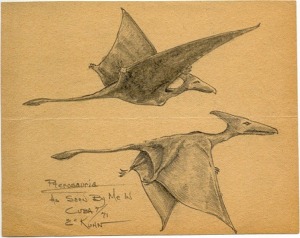in Cuba
Pterosaurs
Guantanamo Bay Sighting of Two Ropens
Best-Selling Non-Fiction on Live Pterosaurs
In 1971, a U.S. Marine Observed Two Long-Tailed Pterosaurs Flying in Daylight
Live Pterosaurs, Called "Flying Dinosaurs," are Seen Worldwide and Are NOT Bats
Copyright 2010 Jonathan Whitcomb
Mr. Kuhn had assumed that the two long-tailed pterosaurs he observed were exceptional cases and that short tails were what would be expected of modern living pterosaurs. That was before his 2010 interview with cryptozoologist Jonathan Whitcomb. Most sightings do involve long tails.
Guantánamo Bay Naval Base is located on 45 square miles of land and water at Guantanamo Bay, Cuba which the United States leased for
use as a coaling (fueling) station following the Cuban-American Treaty of 1903. The base is located on the shore of Guantánamo Bay
at the southeastern end of Cuba. (Wikipedia)
Don't be mislead by old tales about bat-misidentification. Scientists and professionals in various fields are eyewitnesses of large pterosaurs, very much non-extinct pterosaurs: cryptids obviously not bats.
The nonfiction book "Live Pterosaurs in America" is the best-selling cryptozoology book on living pterosaurs (Amazon). Read
about where these creatures fly in the United States of America.
Flying Creatures In Cuba
"It was a beautiful, clear summer day . . . most of the platoon was in the new barracks "hanging out". I was looking in the direction
of the ocean when I saw an incredible sight. It mesmerized me!
"I saw two pterosaurs . . . flying together
.
. . perhaps 100 feet [high], very close in range from where I was standing, so that I had a perfectly clear view of them.
"The structure and the texture of the wings appeared to be very similar to that of bats: particularly in that the struts of
the wings emanated from a "hand" as fingers would, except that a couple of the fingers were short (as for grasping) and the
other ran out to the tip of the wing, others back to the trailing edge of the wing to stretch the wing membrane as a kite would."
--Words of Eskin C. Kuhn
The Flying Fox fruit bat in captivity---it still sleeps in the daylight hours, for this kind of bat is a creature of the night: nocturnal.
Some were shown in the second Indiana Jones movie.

Sketch Drawn by Eyewitness Eskin Kuhn
Details from 1971 sketch coorelate with recent reports
Drawing by Eskin Kuhn, soon after the sighting
at the U.S. military
base in Cuba
at the U.S. military
base in Cuba
Compare with descriptions of
"ropen" in Papua New Guinea
"ropen" in Papua New Guinea
8-12 foot wingspans
Please report any sighting to Jonathan Whitcomb ("Email" at top-right of this page) Thank you.
Photo by NewsHour